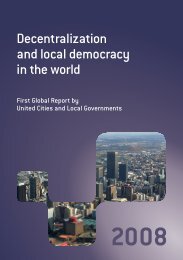Making Cities Resilient Report 2012
Making Cities Resilient Report 2012
Making Cities Resilient Report 2012
Create successful ePaper yourself
Turn your PDF publications into a flip-book with our unique Google optimized e-Paper software.
CHAPTER 3 | Key Trends on Resilience-Building in <strong>Cities</strong><br />
City size and economic base<br />
Institutionalized community participation is not<br />
limited to low-capacity contexts, as exemplified<br />
by Oak Bay in Vancouver, which is a Campaign role<br />
model on the basis of its participatory approach<br />
to resilience building. The success of participation<br />
in small, low-density urban areas in high and low<br />
capacity contexts could be explained in part by the<br />
existence of a more personal connection between<br />
local government and the public, or because more<br />
rural livelihoods often mean that communities are<br />
more directly affected by the impact of relatively<br />
small-scale hazard events (such as damage to<br />
crops), and are therefore more motivated to take<br />
part. The main challenge for institutionalizing<br />
public participation in large cities is up-scaling,<br />
although much can be learned from the city of San<br />
Francisco (USA) – a highly developed and large<br />
city with 805,235 inhabitants – which has a wellembedded<br />
community participation programme<br />
(see box 4.4).<br />
Copyright CORILA<br />
Venice’s rich cultural heritage, residents, and tourism industry, faces risks<br />
of flooding and sea level rise.<br />
Smaller towns and cities may suffer from a lack of human capacity and financial resources, and, as a<br />
result, larger and more sophisticated hazard mitigating infrastructure (such as flood drainage, dams,<br />
coastal management) or early warning systems and forecasting technologies tend to appear more<br />
in larger, wealthier cities including Jakarta, Bangkok and Metro Manila. This is also driven by the high<br />
concentration of population and assets in large towns and cities, which necessitates hazard mitigation on<br />
a larger scale. High population density and size also means that emergency management is logistically<br />
more complex in large towns and cities, demanding particularly solid institutions for coordinated risk<br />
response. This explains the strong focus on institutionalization in many large cities, including Jakarta,<br />
Mumbai and Makati.<br />
This is not always the case and many smaller municipalities have found ways of overcoming capacity<br />
challenges in order to introduce highly complex technological, institutional and structural risk management<br />
systems. Decentralization of disaster risk reduction resources from national to local government is a key<br />
mechanism for this, while many municipal governments have also made use of partnerships, including<br />
with NGOs and the private sector. Chacao, Venezuela, for example, has a modest resident population of<br />
71,000, but a highly sophisticated warning system that includes wireless communications technology.<br />
Again, the public can also be a valuable resource to assist in forecasting and early warning, illustrated<br />
for example, in Ancona, Italy, where neighbourhoods have landslide monitoring equipment that feeds into<br />
real-time slope stability monitoring at the city scale.<br />
In summary, many factors affect the types and effectiveness of resilience building activities cities<br />
undertake. A useful distinction is that between activities seeking to improve structural resilience (risk<br />
mitigation strategies that seek to resist the impact of hazards) as opposed to social resilience (activities<br />
which strengthen the coping capacity of communities). A combination of both approaches is necessary<br />
to reduce both exposure and vulnerability to disasters. To date, generally speaking, larger cities tend<br />
to focus more in institutionalization and mitigating infrastructure (focusing on structural resilience),<br />
while municipalities with less intense urban development have undertaken proportionally more social<br />
development and livelihood promotion activities (greater focus on social resilience). <strong>Cities</strong>’ experiences<br />
also show that these associations cannot be assumed and there are many exceptions to the rule. Rather,<br />
resilience outcomes are shaped most strongly by the environmental and governance landscape of the city.<br />
<strong>Making</strong> <strong>Cities</strong> <strong>Resilient</strong> <strong>Report</strong> <strong>2012</strong> | 37

















